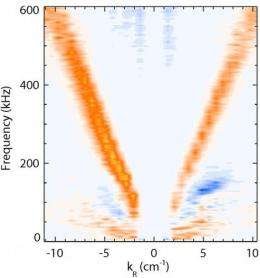Unexpected connection: Rotation reversal tied to energy confinement saturation

Research on the Alcator C-Mod experiment at MIT has made an unexpected connection between two seemingly unrelated but important phenomena observed in tokamak plasmas: spontaneous plasma rotation and the global energy confinement of the plasma.
Self-generated flows, the spontaneous plasma rotation which arises even when there is no external momentum input, can have a strong beneficial effect on plasma transport and stability. But in a fusion reactor, unlike most current experiments, there will be little or no external rotation drive—thus it is crucial to understand and be able to predict plasma rotation under these conditions. In the discharges studied at Alcator C-Mod, the flows can reverse direction at a very precise transition point, depending on plasma density and current.
This flow reversal turns out to be tightly connected to the global energy confinement of the plasma. Since the early days of tokamak research (1970s), it was known that the energy confinement time (the ratio of the energy content of the plasma and the total input power) increased as the density of the plasma increased. This generated a great deal of excitement since one of the goals of fusion research was to operate at high density with good confinement, so this improvement was a bonus. At high enough density, however, the energy confinement stopped increasing.
The results of these experiments suggest that energy confinement and rotation reversal are closely related. At low density, where the energy confinement time increases with the density, the plasma rotates in one direction at roughly +5 km/s. Then at the critical density, the rotation direction reverses direction to values around -20 km/s and the energy confinement saturates. The critical density depends on plasma conditions, increasing with plasma current and decreasing with machine size.
These observations reveal the fundamental connection between the two phenomena and how they both depend on the nature of the underlying plasma turbulence. One hypothesis is that at low density, the turbulence is driven by trapped electron modes, which strongly degrade the confinement and which propagate in a particular direction. As the density is raised, these modes are suppressed, and turbulence driven by ion temperature gradients dominates. These modes at higher density regulate the confinement and propagate in the opposite direction. Evidence for this explanation is emerging from careful measurements of plasma fluctuations.
Provided by American Â鶹ÒùÔºical Society



















